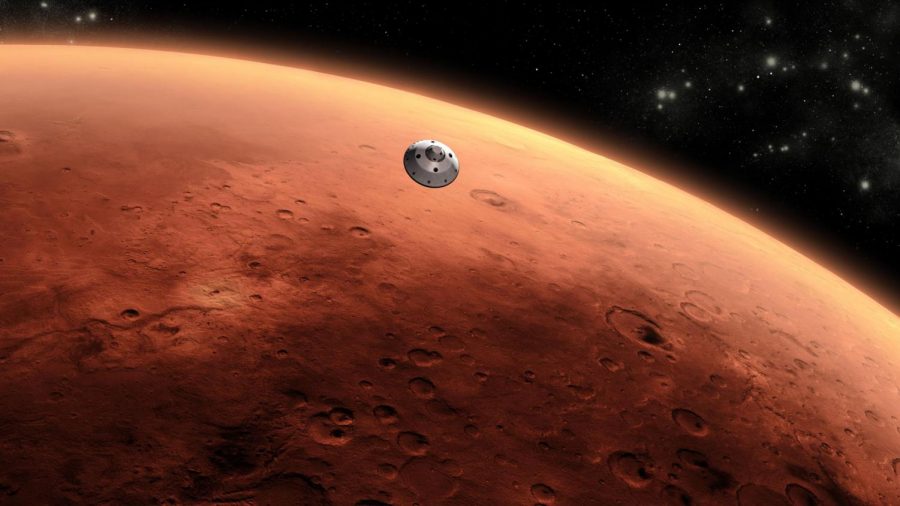Stop looking to the stars, we must protect our home
Photo courtesy of Creative Commons
An artist’s rendering of NASA’s rover descending towards Mars in August 2012.
June 10, 2020
Since the Industrial Revolution, our planet has been on a path towards environmental destruction. Humans are responsible for this due to our tampering with the Earth’s air cycle, naturally alternating between 160 and 300 parts per million (ppm) of carbon dioxide in the atmosphere. For hundreds of thousands of years, the cycle continued uninterrupted, however, after 1900 CO2 levels have skyrocketed to all-time highs (420ppm) and show no signs of returning to manageable amounts.
If the human race does not wean itself off non-renewable resources in the next ten years and drastically reduce emissions, the planet will slip past the point of no return and an extinction-level event will follow. But, the COVID-19 pandemic has given much hope regarding the planet’s future, showing to the world that humanity is capable of repairing Earth and halting climate change. When nations reopen the economies of the world, they must do so with a new mindset, focusing on healing the only home life has.
But many organizations and people, such as Elon Musk and Mars One, are calling for Mars to become the new home of the human race, encouraging many to consider this an alternative to climate recovery. However, this would be a grave mistake as the world neither has the capability to do so nor is it likely to be successful. Although space travel and exploration are essential components of human advancement, our primary mission must be mending our current planet and increasing funding for environmental cleanup efforts.
Life in the form we are familiar with can only survive in small regions of select star systems dubbed “Goldilocks Zones”. The zone consists of a thin invisible ring containing planets that can host liquid water on their surfaces. Temperatures are neither too hot to boil water, nor cold enough to freeze it all.
Out of the 100 billion exoplanets in the Milky Way, scientists speculate a sizable 40 billion are Earth-sized and orbit stars in their Goldilocks Zones. Though, NASA has only identified 20 planets to be suitable for human life. Even if these planets are suitable for life, they are situated thousands of light-years away from Earth. With current technology, humans would never be able to colonize these celestial bodies. One may argue that humans can develop light-speed starships, but the creation of these technologies would take centuries, and there simply is not enough time.
The aforementioned individuals and companies claim Mars is suitable for life in the future due to its position in the sun’s Goldilocks Zone, though it’s harsh landscape and thin atmosphere means humans would never be able to live outside protective suits and vacuum-sealed pods. If humans were to try and migrate to this planet, we would likely go extinct, or shrivel down to a measly number of inhabitants, greatly threatening the future of our species.
Some propose a solution of terraforming Mars, which involves growing plants and other organisms on the surface so they can produce carbon dioxide and thus, create a breathable atmosphere similar to Earth’s. However, there is no foolproof method of doing so and it would cost trillions of dollars, taking centuries to complete. Ironically, humans will be trying to create a new world via a method that destroyed our original home, possibly destining us for the same fate.
Due to the sheer insanity and low chances of success for the terraforming process, Mars shouldn’t even be an option for our future home as a species. Our best bet would be to focus humanity’s attention on our current planet that we have been engineered for. As stated before, scientists claim we have ten years to halt climate change and save our planet. Many, including NASA, have demonstrated the effectiveness of combating climate change through their efforts in monitoring the sea levels, changes in ice and keeping a record on the overall temperature of the surface.
It seems as if we are ignoring what we have. Earth is our home and it makes no sense as to why we aren’t protecting it. Humans are far more likely to save our planet than find a new habitable one. Comparing costs alone shows stopping greenhouse gasses is far more financially viable than moving humanity to another planet.
The Earth is also the most important and vital thing for humanity in the entire universe. Not only has it created and provided a home for life over the last millions of years, but it is one of the most beautiful and unique parts of the known universe. Its mountain ranges, seas, canyons, forests and so much more must be preserved. Without Earth, humanity, or any known life for that matter, would not exist. We are forever in debt to this magical world, and in turn, must protect it.
Mankind has had the rare opportunity to jump-start its mission to save the planet due to the Coronavirus pandemic. If more people work from home, electric cars populate the roads and cleaner methods of manufacturing are implemented, there may be a chance. But action must be taken immediately, interplanetary colonization must wait.


